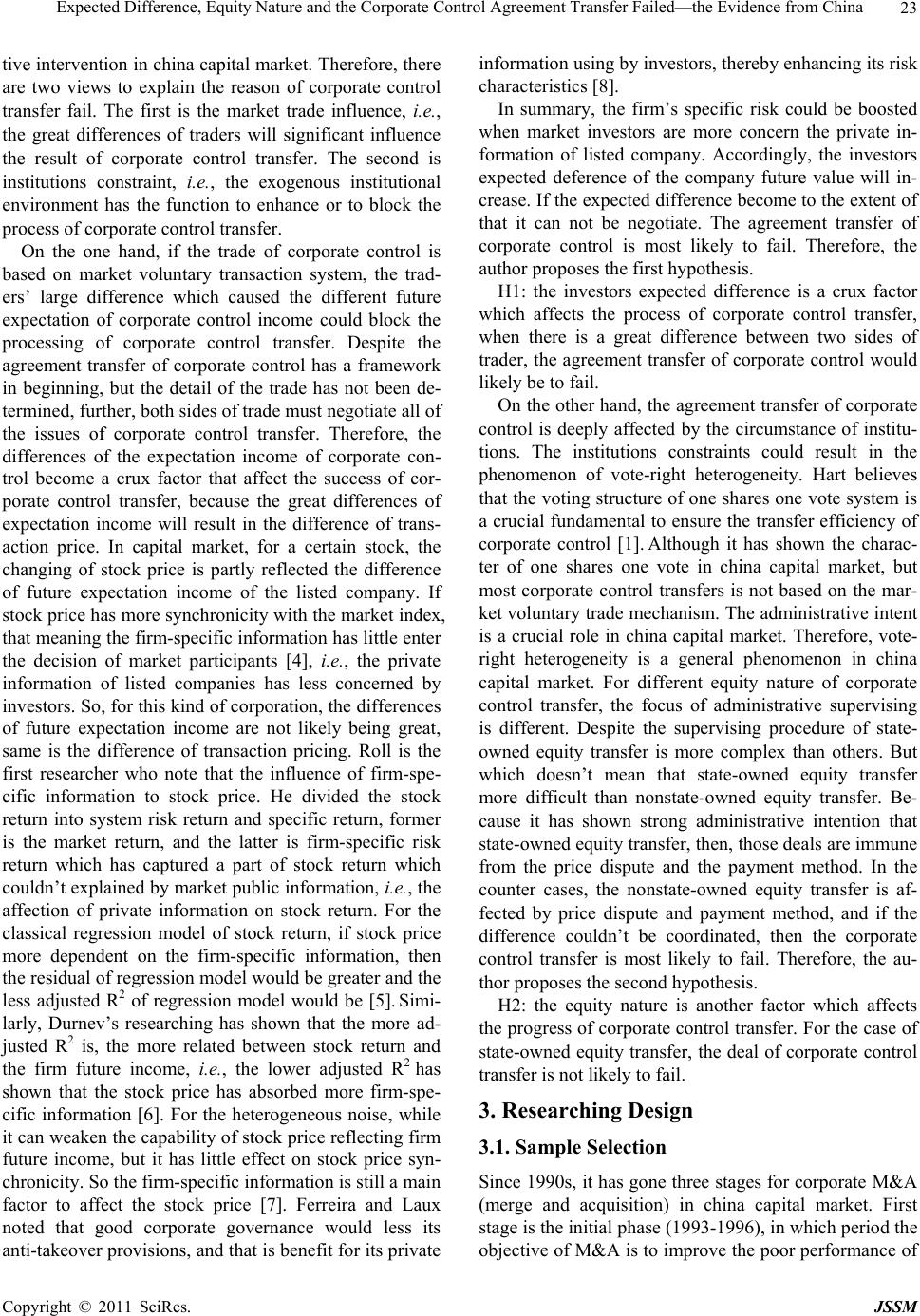
Expected Difference, Equity Nature and the Corporate Control Agreement Transfer Failed—the Evidence from China23
tive intervention in china capital market. Therefore, there
are two views to explain the reason of corporate control
transfer fail. The first is the market trade influence, i.e.,
the great differences of traders will significant influence
the result of corporate control transfer. The second is
institutions constraint, i.e., the exogenous institutional
environment has the function to enhance or to block the
process of corporate control transfer.
On the one hand, if the trade of corporate control is
based on market voluntary transaction system, the trad-
ers’ large difference which caused the different future
expectation of corporate control income could block the
processing of corporate control transfer. Despite the
agreement transfer of corporate control has a framework
in beginning, but the detail of the trade has not been de-
termined, further, both sides of trade must negotiate all of
the issues of corporate control transfer. Therefore, the
differences of the expectation income of corporate con-
trol become a crux factor that affect the success of cor-
porate control transfer, because the great differences of
expectation income will result in the difference of trans-
action price. In capital market, for a certain stock, the
changing of stock price is partly reflected the difference
of future expectation income of the listed company. If
stock price has more synchronicity with the market index,
that meaning the firm-specific information has little enter
the decision of market participants [4], i.e. , the private
information of listed companies has less concerned by
investors. So, for this kind of corporation, the differences
of future expectation income are not likely being great,
same is the difference of transaction pricing. Roll is the
first researcher who note that the influence of firm-spe-
cific information to stock price. He divided the stock
return into system risk return and specific return, former
is the market return, and the latter is firm-specific risk
return which has captured a part of stock return which
couldn’t explained by market public information, i.e., the
affection of private information on stock return. For the
classical regression model of stock return, if stock price
more dependent on the firm-specific information, then
the residual of regression model would be greater and the
less adjusted R2 of regression model would be [5]. Simi-
larly, Durnev’s researching has shown that the more ad-
justed R2 is, the more related between stock return and
the firm future income, i.e., the lower adjusted R2 has
shown that the stock price has absorbed more firm-spe-
cific information [6]. For the heterogeneous noise, while
it can weaken the capability of stock price reflecting firm
future income, but it has little effect on stock price syn-
chronicity. So the firm-specific information is still a main
factor to affect the stock price [7]. Ferreira and Laux
noted that good corporate governance would less its
anti-takeover provisions, and that is benefit for its private
information using by investors, thereby enhancing its risk
characteristics [8].
In summary, the firm’s specific risk could be boosted
when market investors are more concern the private in-
formation of listed company. Accordingly, the investors
expected deference of the company future value will in-
crease. If the expected difference become to the extent of
that it can not be negotiate. The agreement transfer of
corporate control is most likely to fail. Therefore, the
author proposes the first hypothesis.
H1: the investors expected difference is a crux factor
which affects the process of corporate control transfer,
when there is a great difference between two sides of
trader, the agreement transfer of corporate control would
likely be to fail.
On the other hand, the agreement transfer of corporate
control is deeply affected by the circumstance of institu-
tions. The institutions constraints could result in the
phenomenon of vote-right heterogeneity. Hart believes
that the voting structure of one shares one vote system is
a crucial fundamental to ensure the transfer efficiency of
corporate control [1]. Although it has shown the charac-
ter of one shares one vote in china capital market, but
most corporate control transfers is not based on the mar-
ket voluntary trade mechanism. The administrative intent
is a crucial role in china capital market. Therefore, vote-
right heterogeneity is a general phenomenon in china
capital market. For different equity nature of corporate
control transfer, the focus of administrative supervising
is different. Despite the supervising procedure of state-
owned equity transfer is more complex than others. But
which doesn’t mean that state-owned equity transfer
more difficult than nonstate-owned equity transfer. Be-
cause it has shown strong administrative intention that
state-owned equity transfer, then, those deals are immune
from the price dispute and the payment method. In the
counter cases, the nonstate-owned equity transfer is af-
fected by price dispute and payment method, and if the
difference couldn’t be coordinated, then the corporate
control transfer is most likely to fail. Therefore, the au-
thor proposes the second hypothesis.
H2: the equity nature is another factor which affects
the progress of corporate control transfer. For the case of
state-owned equity transfer, the deal of corporate control
transfer is not likely to fail.
3. Researching Design
3.1. Sample Selection
Since 1990s, it has gone three stages for corporate M&A
(merge and acquisition) in china capital market. First
stage is the initial phase (1993-1996), in which period the
objective of M&A is to improve the poor performance of
Copyright © 2011 SciRes. JSSM